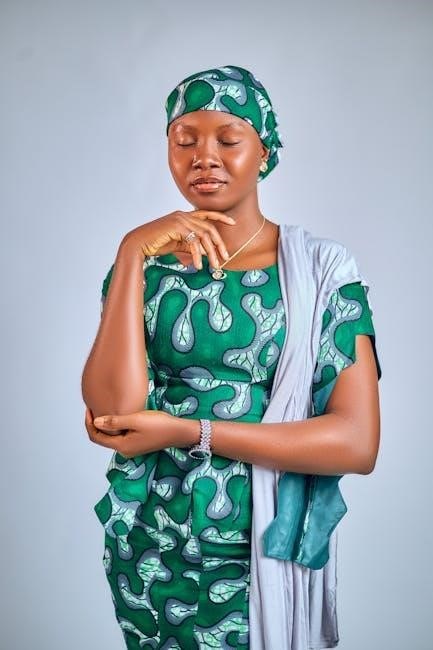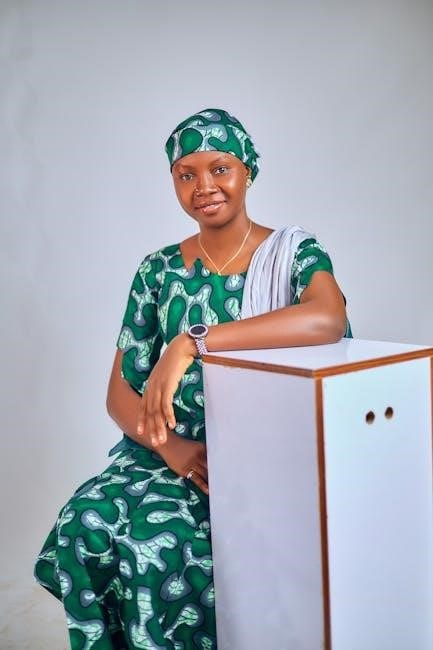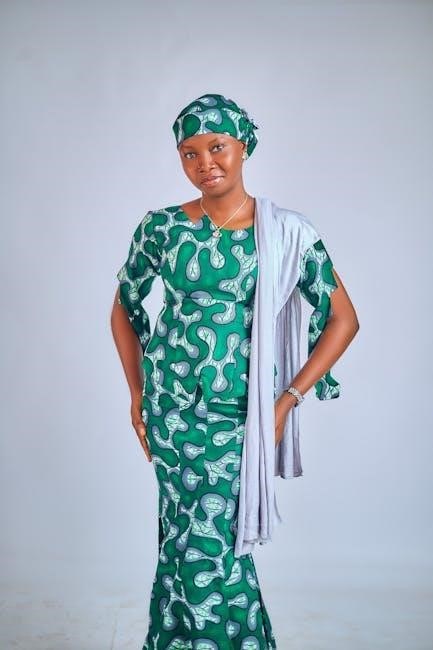Fabric weight, measured in grams per square meter (GSM) or ounces per square yard (oz/yd), reflects a material’s density and thickness, influencing drape, durability, and suitability for various sewing and crafting projects.
Understanding Fabric Weight
Fabric weight refers to the density and thickness of a material, typically measured in grams per square meter (GSM) or ounces per square yard (oz/yd). It is a critical factor in determining a fabric’s suitability for various projects, from clothing to upholstery. Lightweight fabrics, such as chiffon or voile, are soft, breathable, and ideal for flowing designs, while heavyweight fabrics, like canvas or denim, are sturdy and durable, perfect for structured garments or home decor. Fabric weight also influences a material’s drape, durability, and how it performs in different conditions, such as warmth in winter or breathability in summer. Understanding fabric weight helps sewists and designers make informed decisions about which materials to use for specific applications, ensuring the final product meets functional and aesthetic requirements. This guide explores the significance of fabric weight and its impact on sewing and crafting projects.
How Fabric Weight is Measured
Fabric weight is measured using two primary methods: grams per square meter (GSM) and ounces per square yard (oz/yd). GSM measures the weight of one square meter of fabric, while oz/yd measures the weight of one square yard. To calculate GSM, the fabric’s weight in grams is divided by its area in square meters. For oz/yd, the weight in ounces is divided by the area in square yards. These measurements provide a standardized way to assess fabric density and thickness. Converting between GSM and oz/yd is done using specific formulas: multiply GSM by 0.0295 to get oz/yd, or multiply oz/yd by 33.906 to get GSM. Accurate measurement ensures proper fabric selection for projects, as weight directly impacts durability, drape, and performance. This method is widely used in the textile industry to categorize fabrics and guide their application in sewing, upholstery, and home decor.
Fabric Weight Categories
Fabric weight is categorized into lightweight (<150 GSM), medium-weight (150-350 GSM), and heavyweight (>350 GSM), each suitable for different applications, from delicate drapes to durable upholstery and structured garments.
Lightweight Fabrics
Lightweight fabrics typically weigh under 150 GSM (4.5 oz/yd) and are characterized by their softness, breathability, and flowy drape. These fabrics are ideal for clothing requiring softness and movement, such as summer dresses, linings, and sheer curtains. Common examples include cotton voile, chiffon, georgette, and silk fabrics. They are also perfect for delicate projects like wedding veils and light scarves. Lightweight fabrics allow for easy airflow, making them suitable for hot or humid weather. Their semi-sheer to sheer texture adds elegance to designs, and they are often used in garments that require a fluid, airy appearance. However, their thin nature can make them less durable, so they are best suited for projects where delicacy and comfort are prioritized over structure and longevity.
Medium-Weight Fabrics
Medium-weight fabrics fall between 150 and 350 GSM (4.5 to 10.3 oz/yd) and are known for their versatility and balance between softness and structure. These fabrics are ideal for a wide range of applications, from everyday apparel to home decor and upholstery. They offer durability while maintaining a comfortable feel, making them suitable for structured garments like tailored dresses, trousers, and lightweight jackets. Medium-weight fabrics are also commonly used for bags, table linens, and outdoor textiles due to their robustness and ease of handling. Examples of medium-weight fabrics include twill, drill, satin, and jersey. Their balanced weight ensures they drape well without being too clingy or stiff, providing a versatile option for both casual and semi-formal projects.
These fabrics are a popular choice for sewing enthusiasts as they are easy to work with and offer consistent results, making them a go-to for many everyday sewing needs.
Heavyweight Fabrics
Heavyweight fabrics are those with a weight exceeding 350 GSM (10.3 oz/yd), offering exceptional durability and thickness. These fabrics are ideal for applications requiring strength and structure, such as upholstery, outerwear, and specialty items. They provide excellent insulation and are often used in cold-weather garments like coats and jackets. Heavyweight fabrics also include materials like denim, canvas, and fleece, which are perfect for sturdy bags, home decor, and industrial textiles. Their dense weave makes them less prone to wrinkling and gives them a solid, opaque appearance. Despite their thickness, many heavyweight fabrics remain breathable, ensuring comfort in various uses. They are a reliable choice for projects that demand resilience and long-lasting performance, making them a favorite among professionals and DIY enthusiasts alike for their versatility and reliability in demanding applications.

Importance of Fabric Weight in Sewing
Fabric weight plays a critical role in sewing, as it directly influences the final result of a project. Understanding the weight of your fabric ensures proper drape, durability, and functionality. Lightweight fabrics are ideal for soft, flowing garments like dresses and linings, while heavier fabrics provide structure and stability, making them suitable for upholstery, outerwear, and tailored pieces. Fabric weight also determines the appropriate sewing techniques, such as needle and thread selection, seam construction, and the need for interlining. Choosing the wrong weight can lead to a mismatch between the fabric’s performance and the project’s requirements, compromising both aesthetics and functionality. By selecting the right fabric weight, sewists can achieve professional-looking results, ensure longevity, and meet the practical needs of the intended use. This makes fabric weight a fundamental consideration in every sewing project, from casual wear to home decor. Proper weight selection enhances both the process and the final product.
Fabric Weight and Drape
Fabric weight significantly impacts how a fabric drapes, which is essential for achieving the desired aesthetic and functionality in sewing projects. Lightweight fabrics, such as voile or chiffon, have a soft, flowy drape, making them ideal for garments that require movement and airiness, like summer dresses or flowing gowns. Medium-weight fabrics, such as twill or satin, offer a balanced drape, combining structure with flexibility, making them versatile for both structured and semi-structured designs. Heavyweight fabrics, such as denim or canvas, have a rigid drape, providing stability and shape retention, which is perfect for tailored garments, upholstery, or bags. The drape of a fabric is closely tied to its weight, as lighter fabrics tend to be more transparent and pliable, while heavier fabrics are opaque and hold their form. Understanding this relationship helps sewists select fabrics that align with their project goals, ensuring the final result meets both functional and visual expectations.

Fabric Weight and Durability
Fabric weight plays a crucial role in determining the durability of a material. Heavier fabrics, typically those with a higher GSM or oz/yd measurement, are generally more durable and long-lasting compared to lighter ones. This is because heavier fabrics have a denser weave and thicker fibers, making them more resistant to wear and tear. For example, heavyweight fabrics like denim or canvas are often used for sturdy applications such as upholstery or outerwear, where resistance to abrasion and stress is essential. Lighter fabrics, while soft and breathable, may not withstand heavy use as effectively and are better suited for delicate or seasonal projects. The relationship between fabric weight and durability is vital for selecting materials that meet the demands of a specific application, ensuring the final product remains functional and visually appealing over time. Balancing weight and durability is key to achieving the desired performance and longevity in sewing or crafting projects.
Selecting the appropriate fabric weight is essential for achieving the desired outcome in sewing or crafting projects. The weight of the fabric determines its drape, durability, and suitability for specific applications. Lightweight fabrics, such as voile or chiffon, are ideal for projects requiring softness and fluid movement, like summer dresses or delicate curtains. Medium-weight fabrics, such as cotton twill or satin, offer a balance between structure and flexibility, making them versatile for everyday garments and home decor. Heavyweight fabrics, like denim or canvas, are best for sturdy applications such as upholstery or outerwear, where durability and stability are key. Understanding the purpose of the project and the desired aesthetic helps in choosing the right fabric weight. Additionally, considering factors like seasonality and the level of wear and tear the fabric will endure ensures a practical and long-lasting result. By matching fabric weight to project requirements, creators can achieve professional-looking outcomes that meet both functional and visual expectations. Fabric weight plays a pivotal role in fashion, determining the suitability of materials for various garments and accessories. Lightweight fabrics, such as chiffon and voile, are ideal for creating flowing, ethereal designs like summer dresses and sheer curtains. Medium-weight fabrics, including satin and twill, provide structure while maintaining flexibility, making them perfect for tailored suits and everyday apparel. Heavyweight fabrics, such as denim and canvas, are best for durable, long-lasting items like jackets and bags. The weight of the fabric also influences its drape and insulation properties, with heavier fabrics offering warmth and stability in colder climates. Designers often choose specific weights to achieve the desired aesthetic and functionality, ensuring garments are both visually appealing and practically suited to their intended use. By understanding fabric weight, creators can craft garments that meet precise fashion needs, whether for haute couture or casual wear. Fabric weight significantly impacts home decor, as it determines the durability, texture, and aesthetic appeal of various interior elements. Lightweight fabrics like silk and voile are often used for curtains and drapes, providing a soft, airy appearance while allowing natural light to filter through. Medium-weight fabrics, such as linen and cotton, are versatile choices for upholstery, tablecloths, and throw pillows, offering a balance of style and resilience. Heavyweight fabrics, including velvet and jacquard, are ideal for creating opulent drapes, sturdy upholstery, and long-lasting furniture covers. The weight of the fabric also influences its ability to hold dye and patterns, with heavier fabrics typically showcasing bold designs more vividly. By selecting fabrics of appropriate weights, homeowners can achieve the desired ambiance, whether modern minimalism or classic elegance. Fabric weight ensures that each element in a room not only looks beautiful but also withstands the wear and tear of daily life, making it a crucial consideration in home decor projects. Fabric weight plays a crucial role in upholstery, as it directly impacts the durability, comfort, and aesthetic appeal of furniture. Heavyweight fabrics, such as canvas, denim, and jacquard, are ideal for upholstery due to their strength and ability to withstand wear and tear. These fabrics are commonly used for sofas, chairs, and ottomans, providing structural integrity and a luxurious finish. Medium-weight fabrics, like twill and satin, offer a balance of durability and flexibility, making them suitable for less demanding upholstery projects. Lightweight fabrics, such as silk and voile, are less common in upholstery but can be used for decorative accents or vintage pieces, where a softer, more delicate appearance is desired. The choice of fabric weight ensures that upholstered items are both functional and visually appealing, catering to specific design and practical needs. Fabric weight influences needle and thread selection, with heavier fabrics requiring sturdier needles and threads. It also affects seam construction, interfacing, and overall project durability, ensuring proper technique for desired results. Fabric weight significantly influences the choice of needles and threads in sewing. Lighter fabrics, such as those under 150 GSM, require sharp, thin needles to prevent damage and ensure smooth stitching. Heavier fabrics, above 350 GSM, demand heavy-duty needles with larger eyes to handle thickness and density without breaking. Thread selection also varies: lightweight fabrics need fine threads for invisible stitching, while heavyweight fabrics require stronger, thicker threads to withstand wear and tear. Using the wrong needle or thread can lead to poor stitch quality, fabric damage, or even project failure. Understanding the relationship between fabric weight and sewing tools ensures professional results and longevity of the finished product. Proper needle and thread selection is crucial for achieving the desired aesthetic and functionality in any sewing project. Fabric weight plays a crucial role in determining the appropriate seam construction and interfacing for a project. Lightweight fabrics, such as those under 150 GSM, require delicate handling to avoid overwhelming the material. Narrow seam allowances and lightweight interfacing are often recommended to maintain the fabric’s softness and prevent bulkiness. Medium-weight fabrics (150–350 GSM) are more versatile, allowing for standard seam constructions and interfacing without compromising the fabric’s natural drape. Heavyweight fabrics (above 350 GSM), however, demand reinforced seams and sturdy interfacing to ensure durability and stability, especially in structured or load-bearing applications. The choice of interfacing should align with the fabric’s weight to avoid distortion or weakness. For example, heavy fabrics like denim or canvas may require fusible or sew-in interfacings for added stability, while lightweight fabrics like silk or voile benefit from sheer, lightweight interfacings to preserve their fluidity. Understanding how fabric weight influences seam construction and interfacing is essential for achieving professional results and ensuring the longevity of the finished project. Several misconceptions surround fabric weight, often leading to confusion among crafters and sewists. One common myth is that heavier fabrics are always more durable, but this isn’t necessarily true. While heavyweight fabrics like canvas or denim are sturdy, they can be too rigid for certain projects, whereas medium-weight fabrics often strike a balance between durability and flexibility. Another misconception is that fabric weight solely determines a fabric’s suitability for a project. However, factors like fiber content, weave, and drape play equally important roles. For example, a lightweight silk fabric may be more luxurious and durable than a medium-weight cotton fabric, depending on the intended use. Some believe that fabric weight is standard across all materials, but this varies widely. A 200 GSM cotton fabric will behave differently from a 200 GSM polyester fabric due to differences in fiber density and structure. Understanding these nuances is key to selecting the right fabric for your needs. Clarifying these misconceptions helps crafters make informed decisions, ensuring their projects turn out as intended. Fabric weight is standardized across the textile industry to ensure consistency and clarity. Measurements are typically expressed in grams per square meter (GSM) or ounces per square yard (oz/yd), with GSM being the metric standard and oz/yd commonly used in the U.S. These standards help manufacturers, suppliers, and designers communicate effectively about fabric properties. Industry standards categorize fabrics into lightweight, medium-weight, and heavyweight based on their GSM or oz/yd values. For example, lightweight fabrics are generally under 150 GSM, while heavyweight fabrics exceed 350 GSM. These classifications provide a universal reference point for selecting fabrics suitable for specific applications, such as apparel, upholstery, or home decor. While these standards are widely accepted, they can vary slightly by region or industry. For instance, fashion and upholstery may prioritize different weight ranges for their respective needs. Understanding these standards ensures consistency and helps avoid misunderstandings in fabric sourcing and production. A fabric weight chart provides a standardized reference for understanding the weight of different fabrics, measured in grams per square meter (GSM) or ounces per square yard (oz/yd). This guide categorizes fabrics into three main groups: This chart serves as a quick reference for selecting fabrics based on their weight, ensuring the right material is chosen for specific projects. Measuring fabric weight at home can be done with a few simple steps, even without specialized tools. Here’s a step-by-step guide: This method provides an approximate fabric weight, useful for home sewing projects, without needing professional equipment. Eco-friendly fabrics like lightweight organic cotton and heavyweight recycled polyester offer sustainable options, reducing environmental impact while maintaining quality and performance for various textile applications. Eco-friendly lightweight fabrics are sustainably sourced materials designed to minimize environmental impact while offering softness and breathability. Organic cotton, bamboo, and Tencel are popular choices, as they avoid harmful chemicals and promote renewable resources. These fabrics are ideal for summer clothing, linings, and home decor, providing a delicate drape and comfort. Bamboo fabric, for instance, grows quickly without pesticides, making it a highly sustainable option. Tencel, made from wood pulp, uses a closed-loop production process, ensuring minimal waste. Lightweight fabrics like hemp and soy are also gaining traction for their eco-friendly properties. By choosing these materials, crafters and designers can create beautiful, functional projects while supporting sustainable practices. This category balances aesthetics with environmental responsibility, offering a wide range of options for those prioritizing eco-conscious textile choices. Such fabrics not only reduce carbon footprints but also promote ethical production methods, making them a preferred choice for modern, environmentally aware creators. Lightweight fabrics that are eco-friendly are a perfect blend of style and sustainability. Eco-friendly heavyweight fabrics are durable, sustainable materials designed for longevity and environmental responsibility. Hemp fabric is a prime example, made from industrial hemp, which grows quickly and requires minimal pesticides. It is robust, UV-resistant, and ideal for upholstery or outdoor applications. Organic denim is another heavyweight option, produced with fewer harmful chemicals than conventional denim, making it suitable for sturdy garments and home decor. Recycled polyester, crafted from repurposed plastic bottles, offers a sustainable alternative for heavy-duty projects like bags or upholstery. Piñatex, derived from pineapple leaf fibers, is an innovative, eco-friendly heavyweight fabric used for accessories and furniture. Cork fabric, made from cork oak bark, is another sustainable choice, though less common. These fabrics combine durability with environmental benefits, making them perfect for projects requiring strength while supporting eco-conscious practices. By choosing these materials, creators can craft long-lasting products with a reduced carbon footprint, blending practicality with sustainability. Heavyweight fabrics that are eco-friendly are a testament to innovation and environmental stewardship. They offer a responsible way to create durable, high-quality items for various applications. Caring for fabrics by weight ensures their longevity and maintains their texture and appearance. Lightweight fabrics, such as chiffon or voile, require gentle handling to prevent damage. Hand washing or using a delicate cycle with cold water is recommended, followed by air drying to avoid shrinkage or distortion. Medium-weight fabrics, like cotton or linen, can typically withstand machine washing and drying, but using moderate heat settings is advised to preserve their structure. Heavyweight fabrics, such as denim or canvas, are more durable but may shrink if exposed to high heat. Washing them in cold water and drying on low heat helps maintain their size and texture. Ironing should be done according to the fabric type, with lighter weights requiring lower temperatures and heavier fabrics tolerating higher heat. Proper care tailored to the fabric’s weight ensures it remains vibrant and functional for years. This approach prevents damage and extends the life of your materials. Fabric weight plays a crucial role in project planning, as it determines the suitability of a material for specific applications. Lightweight fabrics, such as voile or chiffon, are ideal for projects requiring softness and flow, like summer dresses or drapes. Medium-weight fabrics, such as cotton or twill, offer versatility and are commonly used for everyday garments and home decor items. Heavyweight fabrics, like denim or canvas, are best suited for durable projects, such as upholstery or structured bags. Understanding the weight of your fabric helps ensure that your final product meets both functional and aesthetic goals. For instance, a lightweight fabric might not provide enough stability for a tailored jacket, while a heavyweight fabric could be too stiff for a flowing gown. By considering fabric weight during the planning phase, you can make informed decisions that enhance the success of your project. This step is essential for achieving the desired look and performance of your finished work. Proper planning with fabric weight ensures that your creations are both practical and visually appealing.Choosing the Right Fabric Weight
Applications of Fabric Weight in Fashion
Applications of Fabric Weight in Home Decor
Applications of Fabric Weight in Upholstery
Fabric Weight and Sewing Techniques
Impact on Needle and Thread Selection
Impact on Seam Construction and Interfacing
Common Misconceptions About Fabric Weight
Fabric Weight and Industry Standards
Fabric Weight Chart and Reference Guide

How to Measure Fabric Weight at Home

Fabric Weight and Sustainability
Eco-Friendly Lightweight Fabrics
Eco-Friendly Heavyweight Fabrics
Caring for Fabrics by Weight

Fabric Weight and Project Planning

